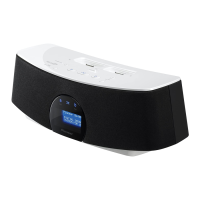
Do you have a question about the Pioneer XW-NAC3-K and is the answer not in the manual?
| Compatibility | iPod Classic, iPod Nano (2nd, 3rd, 4th, 5th), iPod touch (1st / 2nd), iPhone, iPhone 3G, iPhone 3GS |
|---|---|
| Connector(s) | Composite |
Describes the key capabilities and functionalities of the unit.
Lists all the accessories included with the product for user confirmation.
Details the functions and operation of each button on the remote control.
Identifies and explains the controls, indicators, and ports on the unit's front and top panels.
Lists compatible iPod and iPhone models and their supported features.
Provides instructions on how to physically connect an iPod/iPhone to the unit.
Explains how to operate playback functions, volume, and display for iPod/iPhone content.
Describes the function for alternating playback between two connected iPod/iPhone units.
Explains how to quickly find desired tracks by playing short snippets of each.
Explains how to play music wirelessly from Bluetooth-enabled devices.
Guides on setting or changing the Bluetooth PIN code for device pairing.
Provides steps to establish a Bluetooth connection between devices for the first time.
Details how to play music from a connected Bluetooth device through the system.
Warns about potential interference from other devices operating in the 2.4 GHz band.
Introduces the Home Media Gallery function for network audio playback.
Outlines the sequence for connecting, configuring, and using the Home Media Gallery.
Lists supported audio file formats and their specifications for playback.
Instructions for connecting the unit to a network using a LAN interface.
Details how to navigate folders, select files, and play content via the network.
Explains the display information during audio file playback and Internet radio reception.
Instructions on how to register and manage favorite songs and Internet radio stations.
Process for adding custom broadcast stations not found in the default vTuner list.
Covers saving and retrieving Internet radio stations across different classes.
Manual network configuration steps required if the router lacks DHCP server functionality.
Explains how to view current network configuration details like IP address and MAC address.
Feature to limit the maximum volume when controlled by an external device.
Explains the technologies used for network playback, including Windows Media Player and DLNA.
Discusses potential issues and recommendations for network playback performance.
Process for authorizing the unit to access network resources for playback.
How to connect external audio devices via the AUX IN port for playback.
Enhances compressed audio quality by restoring lost sound pressure and smoothing artifacts.
Applies various audio effects like Vivid, Lo-Fi, and ALC to enhance audio sources.
Controls for tailoring the low and high frequency sounds to adjust the overall tone.
How to set the current time and date, which is necessary for timer functions.
Option to switch the clock display between 12-hour and 24-hour modes.
Configures the unit to automatically turn on at a specified time with selected audio.
Activates or deactivates the wake-up timer function.
Sets the unit to automatically turn off after a specified period for sleep.
Provides solutions for common operational problems and error indications.
Restores all system settings to their factory default values.
Explains the technology used to enhance compressed audio quality.
Provides information regarding iPod and iPhone compatibility and usage.
Details the performance specifications of the unit's amplifier.
Provides information on the speaker enclosure and driver specifications.
Lists the specifications related to the unit's network connectivity.
Includes general specifications such as power requirements and consumption.
Instructions for proper cleaning and maintenance of the unit.
